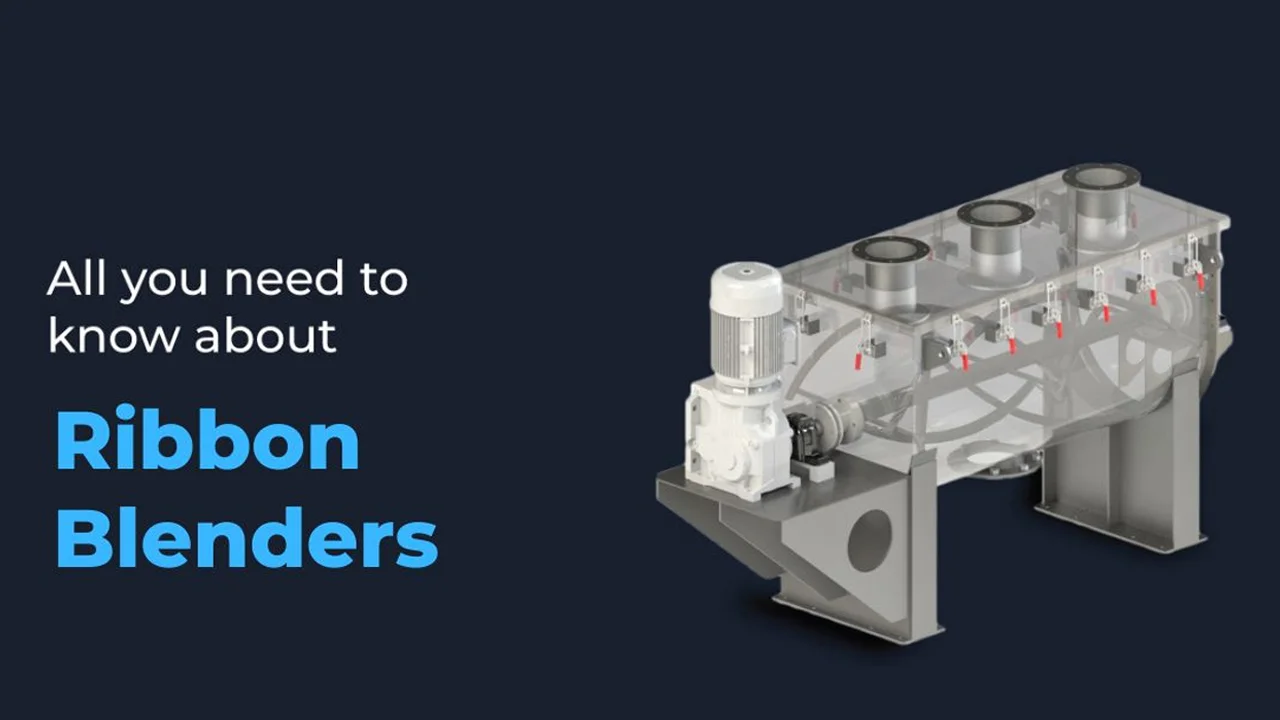- Industries
- Solutions
- Products
- Our Company
- Knowledge
- Contact Us
All you need to know about ribbon blenders

Blending is an essential part of the manufacturing process. The quality of the manufactured product is determined by the texture, form, ingredients, and quantity of the product. Most industries require blenders that homogeneously distribute and are gentle on the products.
Are you starting a blending and mixing business? Don’t know where to start?
With a wide range of blenders in the market, buying them can be tricky. It ranges from a double cone, ribbon blenders, vee blenders, rotating drum, paddle and plow mixers, dry fountain and many more.
And, if you are planning to invest in these cost-effective mechanisms, don’t fret. We’ve got your back. Through this blog, we will guide you about ribbon blenders and tips and tricks for efficient selection.
As the name suggests, ribbon blenders are huge industrial mixers that use ribbons (agitators) to blend and mix materials evenly. With the main purpose to mix and blend dry and wet ingredients perfectly, it is used mainly in food manufacturing, chemicals and medicine manufacturing companies and in the plastic and mineral treatment industrial plants.
Making it easier to mix ingredients on a larger scale without damaging or breaking them, ribbon blenders are the most renowned blending mechanism used by various industries. Best suitable to mix solids with solids and solids with liquids, this highly durable and long-lasting equipment is also known to withstand various amounts of pressure and temperature. It delivers the highest degree of accuracy and efficiency no matter the available quantities of the materials.
Before comprehending the challenging part, let’s understand the features of ribbon blenders and why they are the ultimate solution to homogeneous mixing and quality products.
These quick, effective and top-quality ribbon blenders have securely controlled clearances between surfaces and agitator tips which help them mix ingredients evenly without damaging.
Apart from the above, ribbon blenders have few more advantages that prove them to be more effective and efficient than the other mechanisms and machines.
- Simple and robust design
- Multipurpose mechanism
- Clean and hygienic
- Homogeneity
- Time-saving
- Consistency
- Heating and cooling
- Applicable to various industries such as agro, cosmetics, pharmaceuticals and food
Before diving further let us understand how a ribbon blender works and how they homogeneously distribute materials.
Ribbon blenders are convective mixers. It consists of a horizontal “U” Vessel with a horizontally installed shaft.
The ribbon is made in two parts –
The outer helix moves the material from both ends of the vessel towards the centre, and
The inner helix transfers the material towards both ends, performing a sort of convective mixing.
The mixture movement is forced by the rotation of the ribbon which is circulating the product in two directions. After mixing it for enough time, those 2-axial movements, coupled with some radial movement of blades “cutting” the material when rotating, allows it to reach the required degree of homogeneity.
The myriad range of ribbon blenders makes the process to buy it difficult and tricky. Considering some factors before making a decision makes the process a lot easier. From choosing the speed to ingredients that you have to mix – everything plays a significant part in the selection. Here are a few factors that will help you choose the right ribbon blender for your ingredients and process.
SIZE AND VOLUME
The volume is the most important aspect of the ribbon blender. Selecting a blender that will help you evenly mix the amount of material you are looking for depends on the size of the blender.
In some cases, a large blender might be more suitable than a smaller one. In other cases where you want to avoid a shut-down, multiple smaller blenders will help you optimize the process and save time.
Similarly, the swept volume should also be considered for efficient mixing. It is the area occupied by the agitator. Keep in mind that the length of the mixer should not exceed 2.5 times the diameter of the agitator.
POINT TO REMEMBER:
Mixing capacity should be 70-80 per cent of the total vessel space as it gives enough area for the material to flow.
DRIVE ARRANGEMENT
Drive arrangement of a ribbon blender is a crucial setting to decide before you make a purchase. Arrangements such as a direct one-piece motor reducer, or Gearmotor increases the efficiency and reliability of the overall system. This method of direct drive arrangement is flexible and can accommodate high start/stop blending cycles. Compared to belt and chain drives which suffer from losses in horsepower and efficiency through slippage.
MATERIAL OF CONSTRUCTION & SURFACE FINISH
Depending on the application, the ribbon mixers are made from both mild and stainless steel. Industries such as Pharmaceuticals require stainless steel mixers with special finishes so that they can be easily cleaned and sanitized.
Another thing that determines the material and finish of ribbon blender is the corrosive nature of the ingredients. If the ingredients are corrosive and the mixer used is made of mild steel then it would dissolve by the ingredients over time.
RIBBON DESIGN
A ribbon mixer successfully mixes materials by agitating them with a corkscrew-like metal blade known as ribbons and its movements lead it to proper blend.
Your ribbon type will determine the quality mixing in less time ensuring effective evacuation at discharge and saving you time, money and energy. But, for a balanced selection – the challenge is to induce vigorous agitation without over-stressing the ribbon, rods and shaft.
An efficient ribbon design will not only blend quickly and produce minimal resistance but also determines long term reliability.
HORSEPOWER
Most ribbon mixers operate at around 20 RPMs. Mixers with dual agitators or wider ribbons require less time to mix but they increase horsepower.
POINT TO REMEMBER:
Motor with appropriate horsepower also plays a major role in perfect mixing. If the horsepower of the installed motor is more powerful than required then it will lead to added expenses. Whereas, underpowered motors won’t be able to start under load.
Nature, type and quantity of your materials highly influence the perfect type of ribbon blenders for your industry. For example –
- To find out the appropriate blender class from standard and heavy-duty, it is essential to identify product bulk density.
- Industry-wide, most standard Ribbon Blenders typically handle bulk densities of around 550 kg/m3. But, if you have denser materials, you should use more robust blenders.
- If you intend to produce different recipes in one blender, factor in the lowest and highest densities. This will help you come up with the correct blender capacity and motor size.
- Also, if your material is dense or viscous, you may need an agitator that has a higher degree of shear.
- Contrary, if your materials are fragile and can break easily while mixing, it is advisable to use a gentler agitator, such as a vertical cone screw mixer, paddle mixer or operate with lower speed.
CLEANING PROCESS
The easy cleaning process and in some cases, removable ribbons also play a wide role in selecting a ribbon blender. Tedious and complicated cleaning process indirectly leads to less efficiency and a slow production process.
A well-designed blender is well-polished and each ribbon is designed at such a radius that it prevents material buildup. Most of the blenders are cleaned either with a brush, steam, air or water spray.
POINT TO REMEMBER:
Tight tolerances of (1.6 to 0.8 mm) between ribbon blades and blender trough minimize the amount of residual product in the machine after discharge.
SEALS & DISCHARGE VALVES
Not just the process of blending but how your ingredients exit the mixer is also an essential factor while deciding on a ribbon blender for your industry. Usually, a valve is a manually operated slide paddle. But, alternative valves are required sometimes for vacuum operations. One such valve is a spherical disk valve, which provides a positive seal during vacuum blending, while it also offers a large discharge port for fast discharge.
POINTS TO REMEMBER
- More thorough discharge means less cleaning, greater accuracy, and less risk of cross-contamination between batches.
- Industries that require sanitary designs, quickly disassembled split seals/glands are provided for easy cleaning after every batch.
- A drop bottom discharge gate fully releases materials in the mixer immediately.
- Install lantern rings on the packing gland when handling fine or abrasive powders.
- If you are looking for an option that reduces dusting, secure the gasketed cover with a dust-tight discharge valve and clamps.
EQUIPPED WITH ELECTRONIC SLOW START CONTROLLERS & VFD
A sudden or a fast start always damages the ingredients and lowers the reliability of the system. Instead, these electronic slow controllers lead to a slow start under full load and protect the system against a spike in start-up torque and amperage.
Also, if you have numerous products to blend, adjusting the peripheral speed of the ribbon is an advantage to your system.
PROVISION OF HEATING AND COOLING
Blender with jacketed design or electric coil helps to heat and cool the material while blending at the same time, thus helpful especially in the food industry by acting as a blender cum roaster or blender cum cooler.
Now that you understand the factors that determine the efficiency of the ribbon blender, things will be less complicated when you decide to buy the ribbon blender.
If you are looking to invest in a ribbon blender, worry not! Here’s the list of ‘RIECO-approved’ points that you need to keep in mind while making your purchase.
BUYING A RIBBON BLENDER
Before buying a ribbon, answer the following questions to understand the right blender specifications for your factory –
- What is the expected throughput of the line?
- What is the product density to be mixed?
- What is the expected mixing time and cycle time?
The above questions will solve your query about the size of the ribbon blender.
- Does it require cleaning very often?
- Does your product need frequent thorough discharges or discharge at the end?
Such questions will help you identify the access doors of the blender which will help you with easy discharge and a cleaning process.
- Is the application handling an abrasive product?
If yes, keep in mind the material of the ribbon blender and the ribbons themselves.
- Is it in the ATEX area?
If yes, the blender must be certified, the clearance paddle/housing guaranteed, the seals of bearing must be pressurized and possibly their temperature monitored
Keep the above things in mind while selecting a ribbon blender for your business. It will not only ease the complicated process but will also eliminate any concerns and problems.
Always remember, choosing a ribbon blender that is efficient, easy to clean, ergonomically designed and consumes low power is the right blender.

